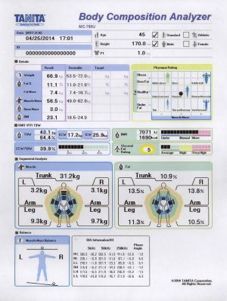Assessing Body Composition – Determining Your Present State of Health, Disease Risk and Treatment Progress
BY: DR. TORY JACKSON
Why Is It Important to Measure Percentage Muscle, Fat and Fluids in Various Body Compartments?
Research shows body composition is directly related to health. Along with age, gender, body build and activity we use body composition measurements to gain insight into metabolic rate, toxic load, level of hydration and risk of disease. It will also measure the effectiveness of any weight loss or physical activity program. Other important measurements include bone mass and water inside and outside of cells.
The ratio of increased fat stores as compared to decreased lean muscle mass have been linked to greater risks to cardiovascular disease, diabetes and other conditions of ill health.
We often combine the results of body composition analysis with various other in-clinic tests (darkfield microscopy blood analysis, urine and salivary pH, digital pulse wave analysis, heart rate variability, computerized regulated thermography) to determine a treatment program unique to the patient at their present state of health.
As part of an ongoing treatment program, we perform periodic testing to monitor improvements and maintenance of a healthy body composition for optimal health and aging.
How Does A Body Composition Analyzer Work?
This is an imperceptible, electrical current that passes through body tissues and cells that contain water (fat or muscle cells and spaces that surround cells).
Measurements depict various rates the current moves through tissues and in turn, calculates readings based on computer analysis and logarithms.
The test is almost as fast as weighing yourself on a bathroom scale. Standing on 2 metal pads while holding hand grips, the tester enters patient info into the analyzer. The readings are computed instantly and there is no sensation of the current.
To Ensure the Reading is Accurate, Some Patient Preparation is Required
- avoid strenuous exercise just prior to the test (light activity ok)
- refrain from eating a large meal 3 hours prior to your test (snack is ok)
- patient must be well hydrated, refrain from tea, coffee or alcohol before your test, drinking a large -amount of water for the test will not change body water percentage, but will add weight as ‘percentage fat’
- do not use lotion on hands and feet
- do not wear pantyhose, jewelry removed
Interpretation
 While overall body composition is clinically helpful, it is additionally advantageous to obtain composition of each body area, especially with respect to fat, muscle and water distribution.
While overall body composition is clinically helpful, it is additionally advantageous to obtain composition of each body area, especially with respect to fat, muscle and water distribution.
High values of visceral adipose (fat) tissue (VAT) in the trunk area have been associated with increased risk of lifestyle-related diseases, ie heart disease, high blood pressure and Type 2 Diabetes. In some patients, overall fat percentage may be low while percentage visceral fat may be high.
As well, fat cells are metabolically slow compared to muscle cells. Basal Metabolic Rate (BMR) is the minimum level of energy your body needs to perform physiologic functions. Approximately 30% of caloric intake is used to perform motor movements while approximately 70% is used to perform metabolic functions. This is especially important for weight regulation programs.
Intracellular water (inside the cells) can provide information on hydration levels and cell membrane integrity. A dehydrated cell has a raisin-like shape, where the outer cell membrane folds onto itself. This prevents optimal flow of nutrients and waste products in and out of the cell. It’s additionally difficult for substances, such as hormones to attach to binding sites.
Extracellular water surrounds the cell. When this volume is optimal, there is a balanced concentration of water, nutrients and toxic load. As toxins increase, more water is required to dilute the imbalance and water retention can result (edema).
Contraindications for Certain Patients
Patients with a pacemaker or electrical device cannot undertake this test. In addition, patients with metal allergies to stainless steel may experience a reaction.
To learn more about in-clinic testing and how to undergo a baseline analysis and treatment program based on your individual needs, please contact one of our Naturopathic Doctors at ANMC.
